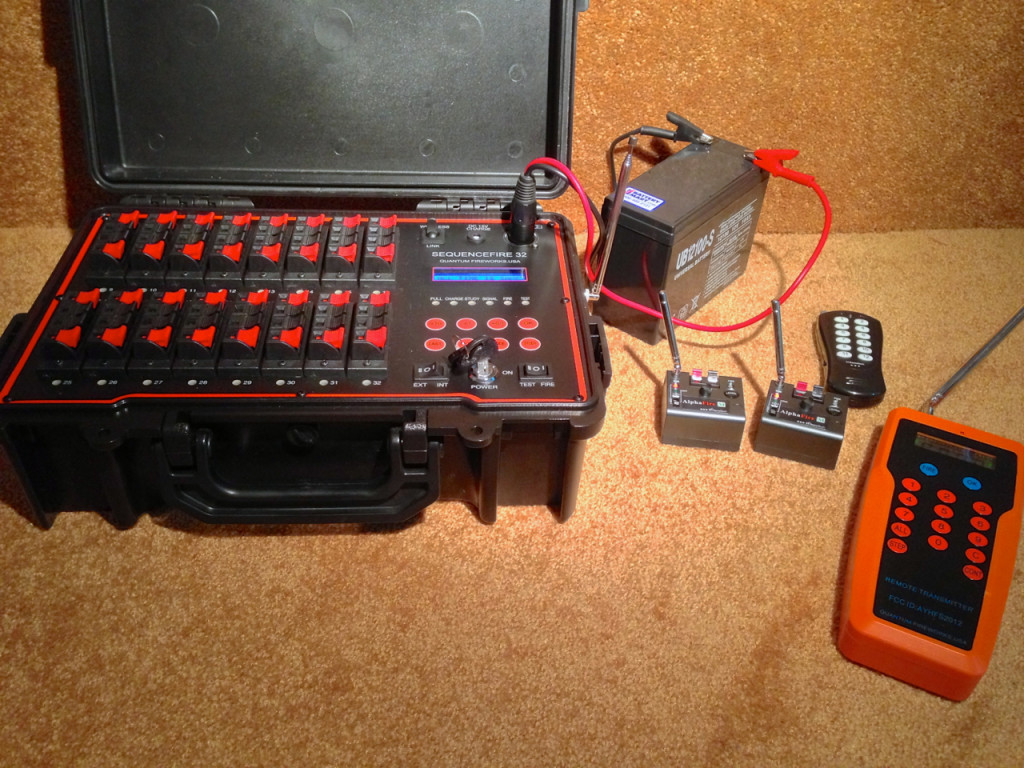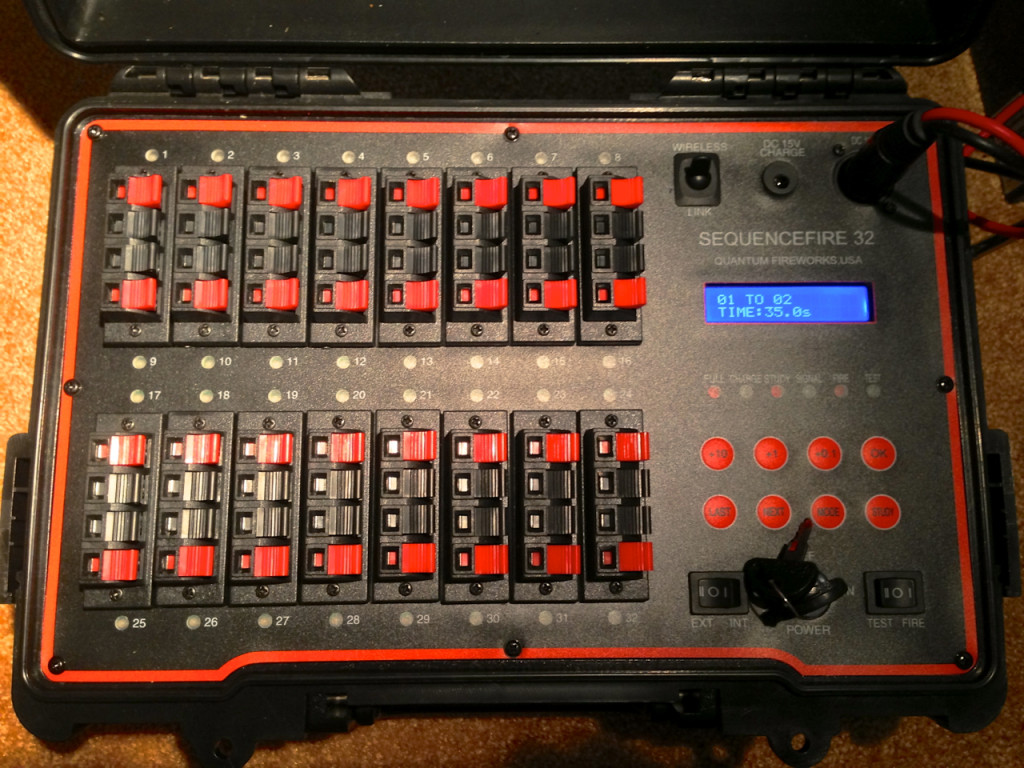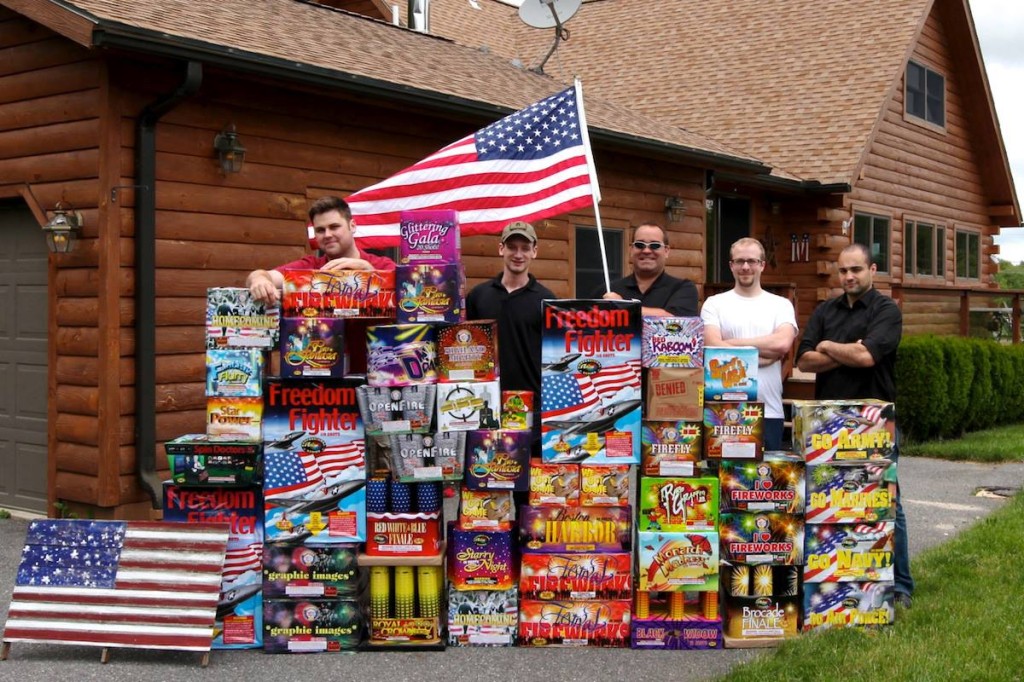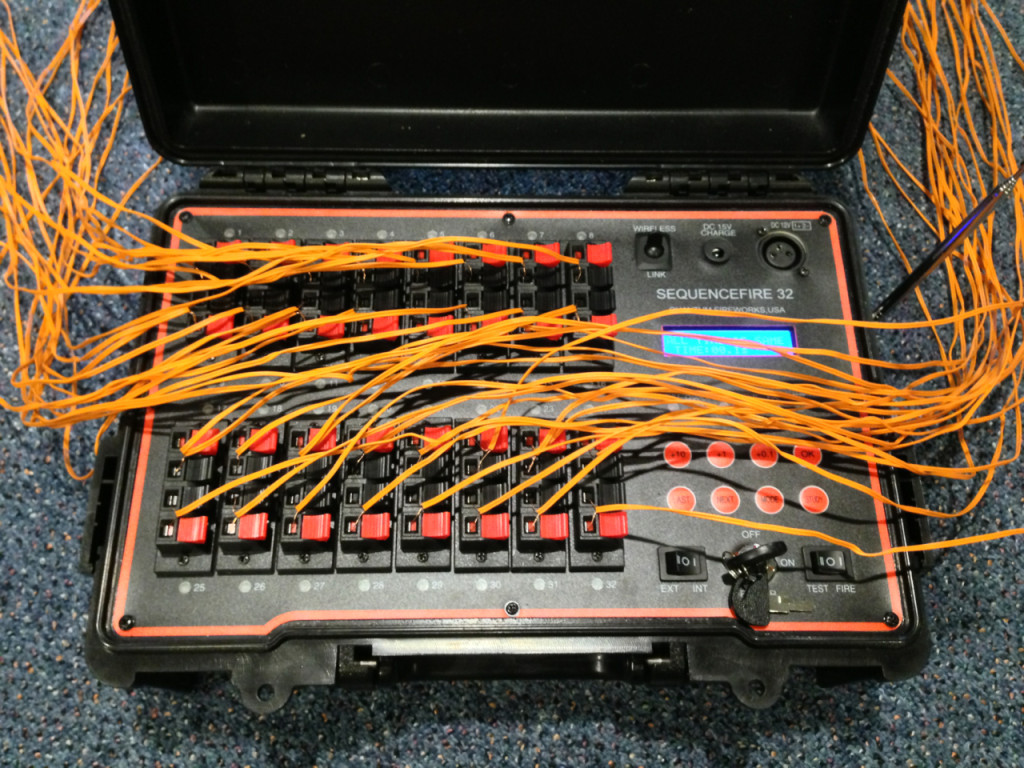I have loved fireworks for as long as I can remember. I love the colors. I love the duality of their danger and beauty. I love the feeling in my chest when a large shell explodes. Since I was little I’ve made it to a fireworks display every 4th of July, however, growing up in a law-abiding Massachusetts family, I never got to experiment with fireworks on my own, save for the few occasions where I convinced my mom to let me buy one mortar. Those few occasions were enough to light the fire in me, and finally when my company had its second annual 4th of July party last summer, I got my first chance to do something with it.
To make a long story short: Two years ago my office had a “fail box.” Every time someone screwed something up they put a dollar in the fail box. The idea was that after a year, we would tally the dollars and do something as a team with the money. Well, after a year we had $1,000 to use and I bet you can’t guess what we spent it on… Yep. Fireworks. A few weeks before the 2nd annual 4th party we went into Atlas Fireworks in Rindge, NH and went on a shopping spree. Mind you, when you spend over $500 at an Atlas Fireworks store, you become a VIP and instantly get a buy one, get one free deal on everything in the store (plus freebees). We walked away with what would normally be $2500 worth of the largest consumer firework “cakes” that you can get, as well as a paper that the manager was nice enough to help me put together. The paper was a list of the cakes that we bought, arranged into a loosely choreographed show, and the day of the party I laid all 37 cakes on the dock at the party, and ran a whopping 65ft of continuous fuse, linking every cake together with carefully measured gaps to time the show. It worked flawlessly. The show ran nearly 20 minutes with 3 false finales and a mind blowing finish. The 50 people at the party were stunned, not to mention the 10+ boats that had stopped offshore to watch half way through. We could hear cheering coming from a half mile away, on the other side of the lake. A rewarding feeling to be sure, given my affinity for careful measurement and organization. I didn’t choreograph it myself, but I timed and launched it with precision, having never even touched a fireworks cake before.

I’ll spare you the long winded explanation, but Quantum Fire was basically out of stock on all their SequenceFires, as well as the igniters that actually light the fireworks. At the last minute (about a week ago) their brand new version — the SequenceFire32 — became available, and Dave at Quantum Fire was good enough to give me a discount on the unit, plus he found the last 150 igniters, sitting on a back shelf, and sold them to me. Along with the SEQ32, I picked up two small units called AlphaFires. These are single-firing-cue, wireless launchers that can be linked to a 12-cue remote. I’ll talk more about the SEQ32 and AlphaFires later. The piece of the puzzle that I haven’t mentioned yet is the fireworks. This year we decided go biggER or go home… We walked into Atlas this year with $1500, and left with nearly $4000 worth of fireworks. Additionally I took it upon myself to plan the show myself this year, and when I plan something, not one single detail goes overlooked.
To this point, this post has been more of a preamble, to the more than 30 hours of planning, thinking, and testing that has gone into preparing this display over the last two weeks. If you’re here to learn about the SequenceFire, there will be plenty on that. If you’d like to know how to plan a back-yard fireworks display to eclipse all others, I’ll give you plenty to think about. If you’ve read my other informational blogs and wonder if I’m a credible source, you will certainly get a glimpse into my mind. Note: If you want to follow along carefully, open this PDF, which contains all of my planning sheets in the order that they fell in the process: 2013 Fireworks Planning.
The Fireworks
For our 2012 party we bought 37 cakes — a cake is basically a cardboard box, housing a self-contained, mini fireworks display. The maximum total explosive charge that a consumer cake can contain (including both the lift charges and the shells themselves) is 500 grams. Last year we had about 20 500g cakes, with the other 17 being a mix of a few 250s, a few 300s, and a bunch of 350s.
For 2013 we bought 41 cakes, with all but 4 being 500g cakes. In all, it’s a lot more boom. The manager at Atlas Fireworks in Rindge was nice enough to help be pick out the most appealing and well-rounded mix of cakes, which I then set about choreographing myself. I began with an inventory of what we had. I then downloaded videos of every cake (most of them are available right on Atlas’s website) so I could time them and evaluate altitude and effect. The result was the first sheet in the aforementioned PDF, containing an inventory, along with a guide to which cake was going to do what, and how high and long it would do it. Next I drew out a timeline at 1 inch = 20 seconds scale (the second and third sheets in the PDF). In pencil first, I started with the finale first (to prioritize the cakes I would need for that) and planned the show backwards, from the end to the beginning. As I planned, I kept mental notes of which cakes I wanted to have displayed on their own, and I referenced my notes to see which are high and powerful cakes, which are lower, which ones have a wide spread, etc. I’m a visual guy, so as I plotted the show and re-watched the videos of each unit, I imagined how they would look layered over each other, and at staggered timing. For example in my timeline you will notice that many of the cakes near the end have an exclamation point somewhere on their time bar. That indicates the point during that cake where the intensity builds. During the 80-second finale, you can see that I chained these end to end a few times, to keep the intensity at a consistent, rising high, without having peaks and falls.
It took about 10 hours to get the choreography just how I wanted it. At the time that I wrote it, I thought the SequenceFires would be out of stock through the 4th, and was going to just fuse the whole show again. Thankfully I was able to order the SEQ32, so I moved on to the next sheet. The 4th sheet is a guide for how much delay needed to exist from one firing cue to the next. You’ll also notice that I only have 32 cues for 41 cakes. A cue can handle up to 5 igniters at once, so a few cues have two cakes running on them. To get staggered timing on a single cue, I’ll be adding a length of fuse with a known burn time (0.5″/sec) to create a delay on the cakes that need it. For example on Cue 3, you’ll see I have both Starry Night and I love Fireworks. I Love Fireworks begins 5 seconds after Starry Night, according to the timeline sheet, so I added 2.5″ of fuse to create a 5 second lag. The left-hand table on the timing acts as a complete guide, where as the right-hand table is laid out strictly for programming the SequenceFire, eliminating extraneous information.

I measured each cake, creating the 5th sheet, and proceeded to draw out the dock in 1mm = 1″ scale. Ready for this? I then drew a scale floor plan of each cake and cut it out in the same scale as the dock. This allowed me to play around with the arrangement of the cakes without doing a crap-ton of erasing to get it right. I started first with the pieces that need to be in a particular spot, relative to another cake. In the finale, for example, I have cakes designated on the left and right to create a more complete spread in the sky. In sheet 6, you will see that 35 and 37 are to the right and left from the perspective of the audience. I also prioritized the placement of directional cakes. Some cakes don’t shoot straight up, but fire at a spread of mild angles to the left and right, to create a wider effect in the sky. I wanted these to be as centered as possible (save for 35 and 37).
The numbers correspond to sheet 7. This is a list of all the cakes in the order that they are to be initiated in, according to the timeline. With the floor plan laid, and the show planned, I then spliced the appropriate wire lengths (a tedious, 6-hour task) and labeled the igniters with the cake that they are to be hooked to. With the igniters labelled, and a floor plan with a cheat sheet, my hope is to be able to lay and fuse the cakes in 30 minutes this year, where as it took 3 hours of running and taping fuse last year.

SequenceFire (and peripherals)
The SequenceFire comes in a 24 and 32 cue version, though the 32 (the new one) has the ability to link with additional SEQ32s for expanded shows, making it a scalable option in addition to being larger itself. It measures about 15x10x5.5″ closed, comes build into a hard, watertight case (not Pelican Case quality, but not too bad), and costs $530. That’s a lot for backyard fireworks — I’ll grant you that — but it’s not bad when you’re shooting annual shows on this scale. If you don’t need to shoot a meticulously timed show, there are much cheaper units that allow for wireless firing of multiple cues. The SEQ32 is really the top of the line before getting into professional firing systems, which cost at least twice as much for an equal number of cues.
Alone, the SEQ32 is a self-contained system with an internal, rechargeable battery. The only peripherals needed (which are included) are the charger and remote. If you’re going to shoot a show using every cue, especially with lengthened wires and multi-igniter cues, an external battery might be smart. Quantum Fire sells one for around $65 which works with the SEQ32. The SEQ32 comes with a connector for clipping to an external battery, and you just plug in the connector and clip it to the battery. It has a switch that allows you to select internal or external power before you power up.

Anyway the SequenceFire is pretty straight forward to use once you figure it out. It’s just important that you’re very conscious of what you’re doing, because you could easily mix up a few igniter leads or put something in the wrong mode and end up with with a dreaded All Fire. I recommend saving the Bud Lite and margaritas for after you shoot the show, lest you mix up your All and Continuous buttons on the remote.


Testing
One day last week I spent an afternoon running tests on all the systems. I went to the show venue with a list of tests that needed to be performed, starting with getting a single igniter to light on the SEQ32, and running up to a live test with the SEQ32 running three 50g mini-cakes, and the whole roman candle rack shooting in the foreground off the AFs. Everything worked like a charm. I was pleased to find that the quoted range on the AFs is actually low-balled. Quantum Fire says 300ft with clear line of sight. We tested at 320 with no problem. Quantum also says the range on the SEQ32 is 350ft, but I’m sure that’s very low. The AFs have a small antena and their remote doesn’t have one. The SEQ32 has a 2ft antena, as does its remote. I wouldn’t be surprised it the SEQ32 could be used reliably at 500+ft with clear line of sight. I’m sure I’ll never know, as if I ever shoot something that far I’ll upgrade to a professional kit, because that’s how I am. Maybe the coolest part of the test day was the full show dry run. I hooked up all 41 igniters in their appropriate cues and just hooked each to a 2″ piece of speed fuse for visible effect. I then started the show with its final timing and clocked the gaps between fuses lighting. It ran perfectly, and I’m confident the show will run to plan. At this point if anything is going to go wrong, it will be me dying of anticipation during the coming 36 hours.
$1500 in fireworks, plus $800 worth of firing kit. At $2300 we might not quite set the world record for most expensive back yard fireworks display, but I’m quite sure that no one attending will have seen anything like it. The net result, if last year is any guide, is an effect more intense than most town firework displays, and about as long. While professional fireworks are much more powerful, you view them from much farther away. When sitting just 50 yards from the launch point, and 25ft above it, the effect is significantly amplified.
I take a ridiculous amount of pleasure in planning and executing something as intricate as this display. I might even go to far as to say I enjoy the perfect execution of the plan more than I enjoy the effect of the fireworks themselves. This year though, I don’t have to light any fuses or stay near the launching point in case the fuse goes out. This year I get to sit with the audience and enjoy the show with a push of a button.



